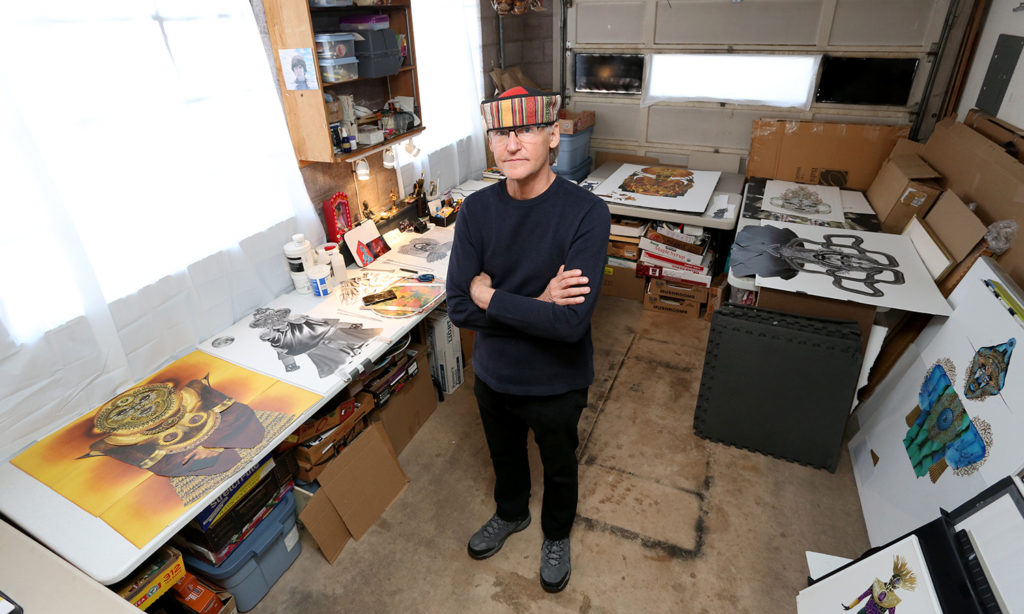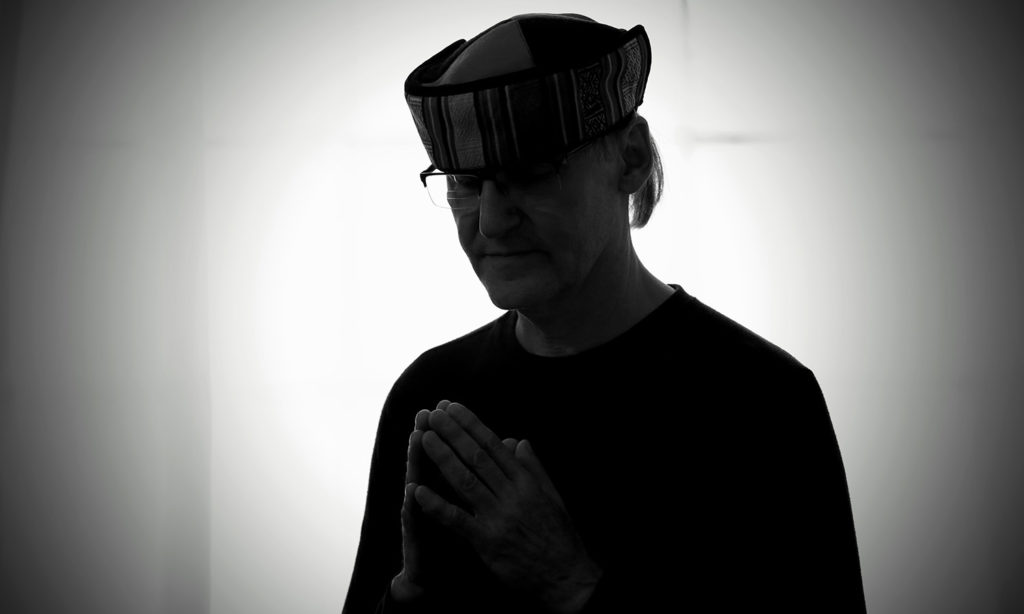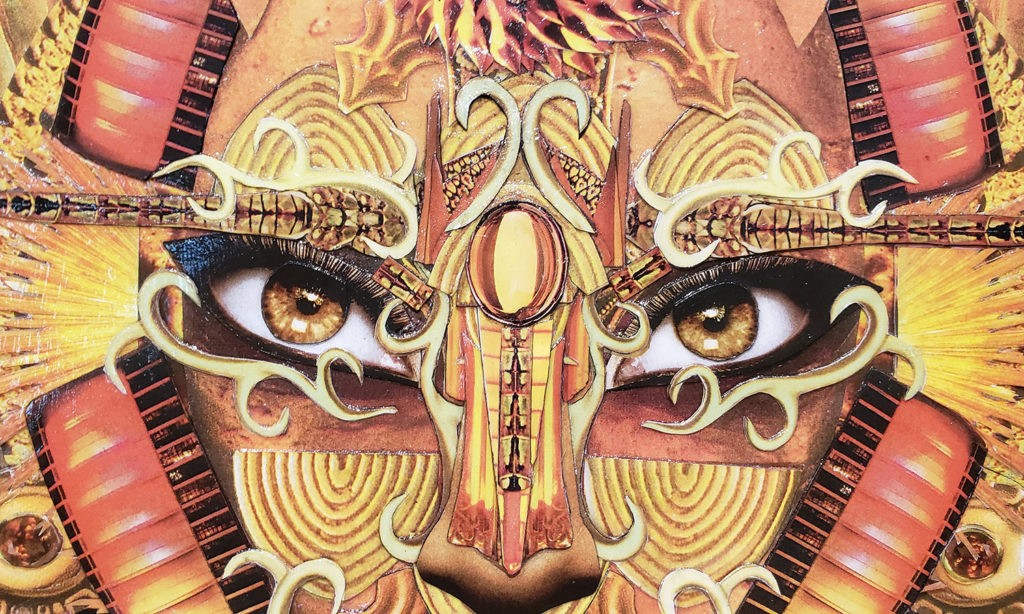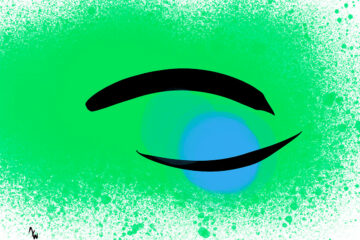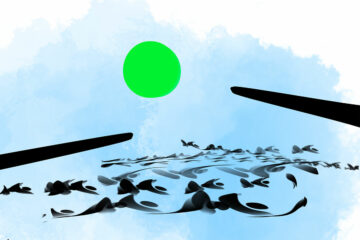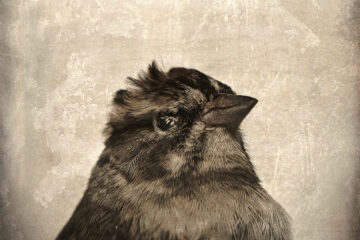There are an estimated 35 to 45 in-progress collage works surrounding artist Robyn Sean Peterson in his home studio. Most of them are stacked upright and leaning against a wall.
There are nearly a dozen pieces in varying sizes — intricate, colorful, mesmerizing — that lie across a U-ish shape of rectangular tables. Beneath them the space is filled with stacks of boxes filled with scraps of source material.
Robyn, 68, earned degrees in Comparative Religion (B.A.) and Psychology (M.A.). Then, on a San Francisco street corner in the 1980s, his intuition pointed him on a new path.
Into art and dimensions beyond.
And, ultimately, into a humble profession that provided conflicting measures of financial stability and struggle but enabled him to continue what mattered most.
When Robyn talked with Humanitou, he shared insights on the intuitive stream that guides his art and the function of art in culture. He talked about manifesting one’s purpose, and an explanation of art’s “trinity of potentials.”
Humanitou: I have read that your artwork is guided by feel or …
Robyn: Intuition. About 99 percent of what I do is intuition and then there’s a one percent logic. I never, ever know what I’m going to work on. It can start with a single piece and I’ll not know why. Then, it’s a process.
All these boxes have so many thousands of fragments of things, whether it’s a strip of cloth or a piece of wrapping paper or a clipping from a magazine.
All I can describe it as is an intuitive stream. It’s intelligent. It will guide me to go and dig out one of the boxes, and start rifling through all this stuff, having no idea, and get me to stop at one piece. From then on, that’s the way that the process goes.
It’s only when the last piece goes in that I have any idea what I was making. Ever. I don’t see anything in my mind’s eye. I don’t have a picture. I don’t do a sketch. Nothing.
It’s like I totally trust this intuitive, intelligent current that makes itself known. And that’s how it comes about.
Humanitou: For many of us, following internal guidance gets lost to the mental controls and the noise of “shoulds.” How have you tapped into that guidance?
Robyn: That awareness and that switch seemed to turn on the very first day I found a piece of a magazine on a street corner in San Francisco. The intuitive voice said, “Put it in your pocket,” and I took it home.
A couple days later, or let’s say maybe a week later, I had been going through the same process and not knowing why, finding these bits and pieces. It was just one night the intuitive voice said, “Get the box with the pieces out.”
Then, it guided me. It showed me the very first piece. I’d say that’s the closest experience for me to experience the divine or some kind of communion with the universe.
All artworks shown are segments of collages by artist Robyn Sean Peterson. They were photographed by Humanitou during Robyn’s 2018 show at the Manitou Art Center in Manitou Springs, Colo.
It’s a relationship where this unseen intelligence is partnering with me and I’m being its hands and its eyes and its mind. But it has the image. It is guiding me so that what’s invisible can be manifested. So, this is where I experience most of my spiritual experience.
In other parts of my life, my intuition informs me just like it does other people, and I might be a little more keen at those times to pay attention to that.
Anything I’ve done is not based on an emotion. It’s not based on trying to get a specific concept across. Since it’s coming from outside, that would be putting me before whatever it is.
I’m a receiver. I’m not an originator at all. These images come from a source. That’s the mysterious part of it.
When I’m working, it’s not like some altered state of consciousness. I’m right there. It’s just that I’m aware of this current, and it’s always accurate. I’m not always accurate.
I could be working on something and I’m just not quite getting it, and it’s just one click on the dial. That’s all it takes is one click and I’ll get what it is. Sometimes the current just shuts down, because it’s just waiting for me to get it.
Sometimes, on accident, I’ll bump a table and a piece will move, and it’s like, “Oh, OK. That was it.” And where I was concentrating was an inch away, that close.
Humanitou: When did that happen in San Francisco?
Robyn: It was in the mid to late 80s. I lived in tiny studio apartment, and I made small pieces for a really long time.
My partner, Leanna Cameron and I — and I must say, without her absolute support and belief in my work, I wouldn’t be at this point in my work. She’s really been the linchpin — have moved to a number of places in the country.
I still had to keep things kind of small. But I started to get the message, “We want to be larger.”
I get why that is. There is something, depending on the nature of the image, the content of what it is, about these pieces that they need to be larger than life.
There’s a particular relationship that they want to create with the viewer, where their eyes are looking into your eyes.
It’s hard for people, especially these days, to calm down, to just slow down, be present and wait. These involve you completely slowing down and waiting.
There is an interaction, if you’re patient, when you’re looking at the eyes, where your being starts to project.
There’s no backstory on any of these images. I only get an image and a title for it. So it can mean absolutely anything to anybody. I think that’s part of the power.
If people are paying attention, it’s about them. It’s about some belief they have, some feeling they have, some concept, some fantasizing or wish fulfillment. It goes down to that level of their own personal soul.
Humanitou: I see a warm, engaged, gentle … I would even say spiritual presence in you. Does that ring true to you?
Robyn: Well, sometimes I’m that. I believe that all of us have many different beings inside of ourselves and, depending on circumstances and our journeys in life, we internalize voices from our past.
If we really know ourselves, if we really look at ourselves, we have a lot of different parts of ourselves. I mean, it’s a clubhouse in here, right? Everybody has a clubhouse in there whether they admit it or not.
When we look out at the world, we can see there’s not a lot of relating to what’s in the clubhouse. It’s a massive amount of projection that’s going on.
Intense, the darkest stuff in people. It’s because, overall, we do not look into ourselves and claim what we are projecting. The repercussions of it in the world are absolutely obvious now.
Humanitou: Is love a lens through which you view and engage the world?
Robyn: It’s the one I try to use. It’s when my being has a not-good reaction to something in the world, it’s the one that I try to find my way back to. It’s constant work. Constant.
When I’m working on artwork, it’s where, for me, the most obvious experience of love is, because I’m unconditionally being given these images. I do my part but when I look at these, every time the emotion I experience is awe. For me, that’s the sacred emotion.
Art is a mirror of the soul. Art is the footprints left by the soul as it passes through time. … [It’s] a bridge to the sacred.
No matter what experience in life that you’re having, when you have that experience of awe, it’s like it’s all the other emotions combined into one thing. It’s love and everything else. Awe is something bigger, something all-inclusive.
When I’m doing these images and, especially, when it’s complete, the fact that it came out of a place that I could not see at all, and because of that relationship I am given this?
That’s love, between spirit and this mortal coil here, this mind, these limitations that I have. I’m just like everybody else. I have my problems, I have my judgement, everything else.
Humanitou: Do people who know how your art comes to be treat you as if you are divine and not like everybody else?
Robyn: It’s an interesting experience. Some people will look at this work and go, “Oh my god, you must have an amazing imagination.” Or, “You must have visions.”
I would probably have those same thoughts if I walked in and this was somebody else’s artwork.
There is a continuing mystique about artists. People tend to attribute to them certain attributes that either elevate them in a certain way or isolate them in a certain way. We’re not special. We’re not.
Everybody has gifts and talents and purpose of some sort in the world. It may not be a profession. When they do that thing, whatever it is, their higher being or their spirit manifests through them. It can be such a basic thing.
I cannot go out and lift the hood on a car and– I can’t do anything with it. I can’t listen to it with an intelligent, attuned ear and hear what that engine is saying is out of alignment, or what it needs. But a person who can do that, they are manifesting their purpose.
They’re just as amazing in their own way as someone who makes a piece of artwork. That’s more practical to people, so they might not hold it in the same level of value.
Humanitou: Making art often is not practical like being a mechanic. So, what is its purpose?
Robyn: I think art is the mirror of the soul.
It’s the mirror of the soul on an individual level. It can be on the community level, on the national level, on a global level. It can mirror suffering. It can mirror our aspirations, our hopes, our fears.
Art is the footprints left by the human soul as it passes through time, and it has a trinity of potentials that it is capable of manifesting.

The first is as a mirror that reflects the world around us and the contents of our mind, our inner and outer life with all of its beauty and horror and everything in between.
The second is that of a portal into the collective unconscious, the wellspring of all myths, religions and symbols, and the abode of the archetypes.
The third potential is that of a bridge to the sacred. In this capacity it facilitates direct perception of higher dimensions of reality and an intuitive comprehension of the mysteries of the universe.
Humanitou: There always are people, for any artist, who just don’t connect with the work. How do you respond internally to that?
Robyn: There’s a lot of different things that come up. It’s hard being an artist. It just is. You just have to know that what you do is not going to be for everybody, and some people may have a negative reaction about it.
It’s a discipline in yourself to be in the presence to hear that and to try and be aware of them saying something about themselves.
When I’m working on my pieces, there’s parts of me in there saying, “Oh, no. Don’t do that. I got this really great idea. You should do this. No, that sucks.” Those are going on.
If I were to listen to those and really let them impact me, just like someone who comes in and looks at the artwork in one of these public spaces, you would get beat down so much.
It’s a discipline. It’s a struggle to believe in the value of what you’ve got, and to believe that whatever gave you that, that intelligence, that generosity of giving that, that above all that’s an important thing, your contract with that.
You put it out in the world and you have no control over that at all.
Humanitou: It’s easy to see work that is published or selected for showing in a gallery and feel like that artist has it all together, that it’s not hard. But every artist I’ve met with for Humanitou has talked about how very human it is to express oneself and live as an artist.
Robyn: Oh, no. The bulk of my life, I’ve mopped floors and scrubbed toilets for people, and I’ve done my artwork on my own, for myself.
Humanitou: Do you mean that literally or figuratively, mopping floors and scrubbing toilets?
Robyn: I mean that literally. That’s what I’ve done.
(Art) is the part of my life where I experience that sacred aspect, which contrasts the unglamourous-ness of that other stuff. I really worked hard for not much money at all.
I had the hope that, at some point, I would be able to meet people who would acknowledge the quality and the content of the work that I did and it would take me into an opportunity in my life where this could be what I do, and I’m able to share with people.
I think this is the best I have to offer the world.
Humanitou: What has been a formative life struggle for you?
Robyn: I’ve struggled financially most of my life. And because I didn’t come to knowing that I was capable of this (my art), I’ve done this other kind of work that didn’t pay much. Hard, odd hours and low pay. So, finance has been a struggle.
In the past, sometimes I’ve had to work two jobs, same kind of work. One in the morning, come home, be home for a few hours and then go in at night and not get home until 1:30 in the morning.
Then, it’s sitting up working on artwork, getting a few hours’ sleep, getting up and doing that over and over again. That takes a tremendous amount of energy from your being to do that.
Some people really struggle that they want to do the thing that they love, but there’s not a way in the world for everybody to be able to do that. It can really puncture people’s souls.
Humanitou: I’m fascinated by a thought here. You chose the janitorial work you did over the years and, to so many people who saw you in that role, they must have thought they knew your story. They had no idea. The education, the tremendous depth of intellect and creative life.
Robyn: It’s probably the same for all of us.
It’s whether we have the opportunities to express these different parts of ourselves weighed up against all the responsibilities we have in this culture.
It really gets to the heart of: We are more than even we perceive ourselves to be.
Learn more about Robyn Sean Peterson on Facebook and in this video produced with Smokebrush Foundation in Colorado Springs.
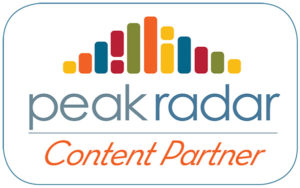 This Humanitou conversation is cross-posted at PeakRadar.com. PeakRadar.com is the Pikes Peak region’s cultural calendar and digital cultural center, connecting residents and tourists with our vibrant arts community. Your source for what’s happening is PeakRadar.com!
This Humanitou conversation is cross-posted at PeakRadar.com. PeakRadar.com is the Pikes Peak region’s cultural calendar and digital cultural center, connecting residents and tourists with our vibrant arts community. Your source for what’s happening is PeakRadar.com!
